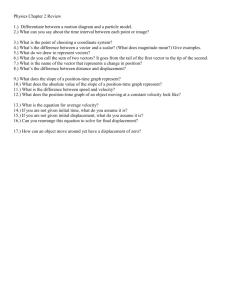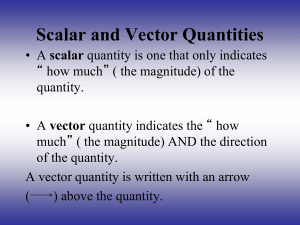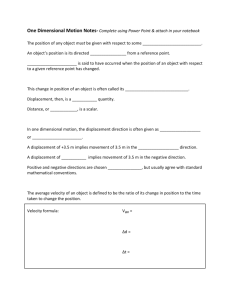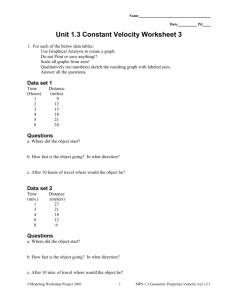Constant Velocity Review Worksheet
advertisement
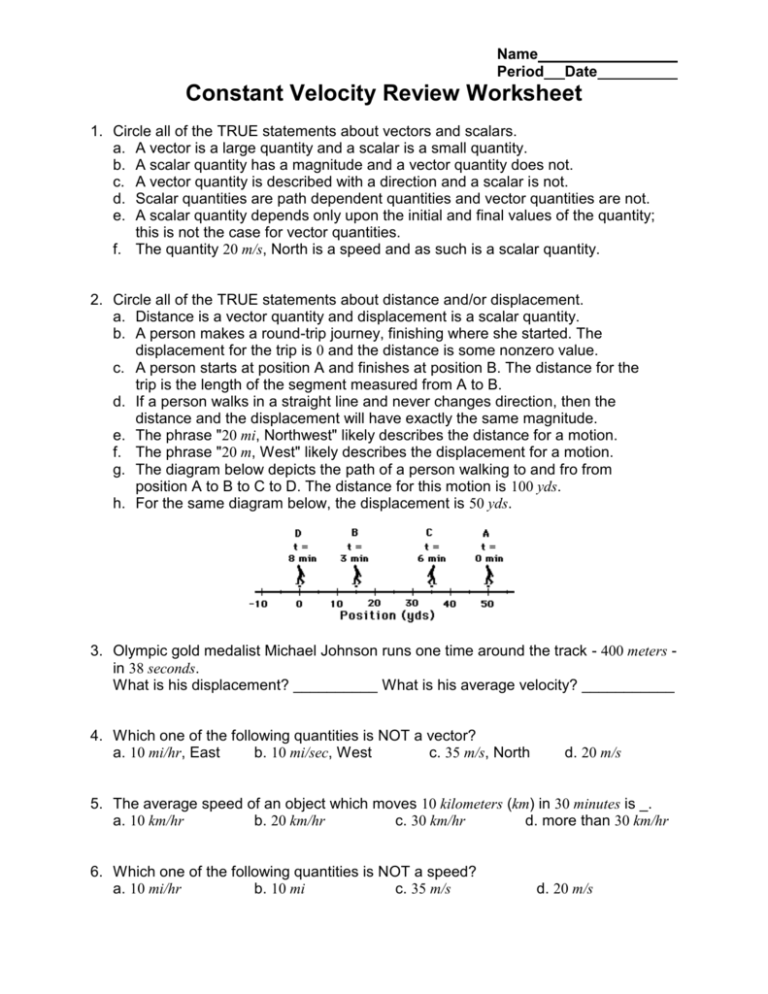
Name Period Date Constant Velocity Review Worksheet 1. Circle all of the TRUE statements about vectors and scalars. a. A vector is a large quantity and a scalar is a small quantity. b. A scalar quantity has a magnitude and a vector quantity does not. c. A vector quantity is described with a direction and a scalar is not. d. Scalar quantities are path dependent quantities and vector quantities are not. e. A scalar quantity depends only upon the initial and final values of the quantity; this is not the case for vector quantities. f. The quantity 20 m/s, North is a speed and as such is a scalar quantity. 2. Circle all of the TRUE statements about distance and/or displacement. a. Distance is a vector quantity and displacement is a scalar quantity. b. A person makes a round-trip journey, finishing where she started. The displacement for the trip is 0 and the distance is some nonzero value. c. A person starts at position A and finishes at position B. The distance for the trip is the length of the segment measured from A to B. d. If a person walks in a straight line and never changes direction, then the distance and the displacement will have exactly the same magnitude. e. The phrase "20 mi, Northwest" likely describes the distance for a motion. f. The phrase "20 m, West" likely describes the displacement for a motion. g. The diagram below depicts the path of a person walking to and fro from position A to B to C to D. The distance for this motion is 100 yds. h. For the same diagram below, the displacement is 50 yds. 3. Olympic gold medalist Michael Johnson runs one time around the track - 400 meters in 38 seconds. What is his displacement? __________ What is his average velocity? ___________ 4. Which one of the following quantities is NOT a vector? a. 10 mi/hr, East b. 10 mi/sec, West c. 35 m/s, North d. 20 m/s 5. The average speed of an object which moves 10 kilometers (km) in 30 minutes is _. a. 10 km/hr b. 20 km/hr c. 30 km/hr d. more than 30 km/hr 6. Which one of the following quantities is NOT a speed? a. 10 mi/hr b. 10 mi c. 35 m/s d. 20 m/s Constant Velocity Review Worksheet Page 2 7. Circle all of the TRUE statements about velocity and/or speed. a. Velocity is a vector quantity and speed is a scalar quantity. b. Both speed and velocity refer to how fast an object is moving. c. Person X moves from location A to location B in 5 seconds. Person Y moves between the same two locations in 10 seconds. Person Y is moving with twice the speed as person X. d. The velocity of an object refers to the rate at which the object's position changes. e. For any given motion, it is possible that an object could move very fast yet have an abnormally small velocity. f. The phrase "30 mi/hr, West" likely refers to a scalar quantity. g. The average velocity of an object on a round-trip journey would be 0. h. The direction of the velocity vector is dependent upon two factors: the direction the object is moving and whether the object is speeding up or slowing down. i. The diagram below depicts the path of a person walking to and fro from position A to B to C to D. The entire motion takes 8 minutes. The average speed for this motion is approximately 11.3 yds/min. j. For the same diagram below, the average velocity for this motion is 0 yds/min. 8. Circle all of the TRUE statements about position-time graphs. a. A straight, diagonal line on a position-time graph is representative of an object with a constant velocity. b. If an object is at rest, then the position-time graph will be a horizontal line located on the time-axis. c. An object with a positive velocity will be represented on a position-time graph by a line with a positive slope. d. An object with a negative velocity will be represented on a position-time graph by a line with a negative slope. 9. Determine the magnitude of the displacement (in meters) of an object which a. moves from Hither to Yon (with an average speed of 28.0 m/s) and then back to Hither (with an average speed of 28.0 m/s) if both the forward and the return trip take 46 minutes each. b. moves at a constant speed of 8.30 m/s in a straight line for 15.0 seconds. Constant Velocity Review Worksheet Page 3 10. Consider the position vs. time graph at right. a. Determine the average velocity of the object. x ( m) 60. 50. b. Write a mathematical model to describe the motion of the object. Be sure to use appropriate variables and units! 40. 30. 20. 10. 0 2.0 4.0 t (s) 6.0 s vm 11. Shown at right is a velocity vs. time graph for an object. a. Describe the motion of the object. 4 2 0 b. Draw the corresponding position vs. time graph. Assume x0 0 m . x (m) 8 t (s) 1 2 3 4 5 -2 -4 c. Using the graph above, how far did the object travel in the interval t 1 s to t 2 s ? 6 4 2 0 d. What is the total displacement? Explain or show how you got the answer. 1 2 3 4 5 t ( s) e. Draw a motion map for the object. Constant Velocity Review Worksheet Page 4 12. Johnny drives from Arizona to Wisconsin (1920 miles) in 32 hours. He returns to Arizona by the same route in 40. hours. a. Determine his average speed. b. Determine his average velocity. 13. Consider the v vs. t graph below. v m s a. Describe the behavior of the object depicted in the graph. 3.0 2.0 1.0 t (s) 0 2.0 4.0 6.0 8.0 10. -1.0 b. Draw the corresponding position vs. time graph. Assume it starts at the origin. x (m) 12.0 -2.0 10.0 -3.0 8.0 c. Draw a motion map that models the behavior of the object. 6.0 4.0 2.0 0 2.0 4.0 6.0 8.0 10. t (s) 14. A racecar travels at a speed of 95 m . How far does it travel in 12.5 s? Use the s appropriate mathematical model and show how units cancel. (Keep the proper number of significant figures.)
